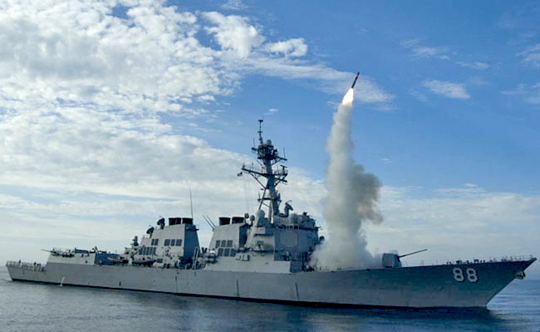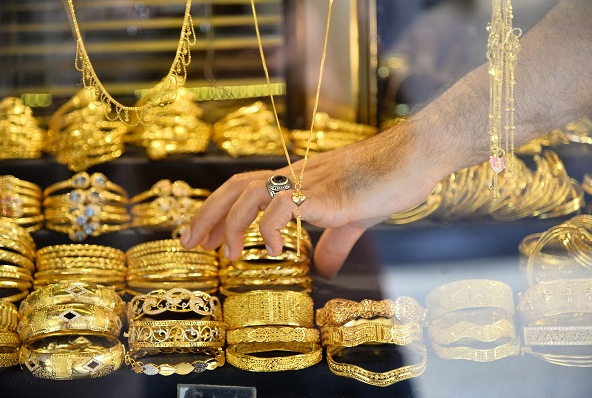Washington, Apr 7: The U.S. military launched approximately 50 cruise missiles at a Syrian military airfield late on Thursday, in the first direct American assault on the government of President Bashar Assad since that country's civil war began six years ago.

The operation, which the Trump administration authorized in retaliation for a chemical attack killing scores of civilians this week, dramatically expands U.S. military involvement in Syria and exposes the United States to heightened risk of direct confrontation with Russia and Iran, both backing Assad in his attempt to crush his opposition.
The attack may put hundreds of American troops now stationed in Syria in greater danger. They are advising local forces in advance of a major assault on the Syrian city of Raqqa, the Islamic State's de facto capital.
The decision to strike follows 48 hours of intense deliberations by U.S. officials, and represents a significant break with the previous administration's reluctance to wade militarily into the Syrian civil war and shift any focus from the campaign against the Islamic State.
Senior White House officials met on the issue of Syria Wednesday evening in a session that lasted into early Thursday, and Defense Secretary Jim Mattis, Secretary of State Rex Tillerson and Army Lt. Gen. H.R. McMaster, the national security adviser, have communicated repeatedly since Tuesday's chemical attack, the officials said.
The U.S. Central Command has had plans for striking the Syrian government for years and currently has significant assets in the region, enabling a quick response once a decision was made.
While the Obama White House began operations against the Islamic State in 2014, it backed away from a planned assault on Syrian government sites a year earlier after a similar chemical attack on Syrian civilians.
Tuesday's apparent nerve gas attack in northern Idlib, with its widely circulated images of lifeless children, appears to have galvanized President Donald Trump and some of his top advisers to harden their position against the Syrian leader.
The assault adds new complexity to Syria's prolonged conflict, which includes fighters battling the Syrian government and others focused on combatting the Islamic State, which despite over two years of American and allied attacks remains a potent force.
Within the administration, some officials urged immediate action against Assad, warning against what one described as "paralysis through analysis." But others were concerned about second- and third-order effects, including the response of Russia, which also has installed sophisticated air-defense systems in Syria, according to the officials, who spoke on the condition of anonymity to discuss internal deliberations.
The Trump administration's position on the strongman appears to have quickly shifted in the wake of the chemical attack, as senior officials voiced new criticism of the Syrian leader.
Earlier Thursday, Tillerson suggested that the United States and other nations would consider somehow removing Assad from power, but he did not say how. Just a few days ago, the White House had said that removing Assad was not realistic with press secretary Sean Spicer saying it was necessary to accept the "political reality" in Syria.
"We are considering an appropriate response for this chemical weapons attack," Tillerson said in Palm Beach, Florida, where Trump was meeting Thursday with Chinese President Xi Jinping. "It is a serious matter. It requires a serious response," he said.
The summit with the Chinese leader will continue Friday, and some U.S. officials believe the strike will also serve as a warning of U.S. willingness to strike North Korea, if China does not act to curtail the nuclear ambitions of the government there.
It was not immediately clear whether Thursday's assault marked the beginning of a broader campaign against the Assad government. While Thursday's operation was the first intentional attack on Syrian government targets, the United States accidentally struck a group of Syrian soldiers in eastern Syria last year in what officials concluded was the result of human error.
The Obama administration had insisted that Assad could never remain in any postwar Syria, and it supported rebel groups that have tried unsuccessfully to oust him.
A senior State Department official said Tillerson spoke on the phone Wednesday with Russian Foreign Minister Sergei Lavrov about the chemical attack.
"We sought the Russian analysis or readout of what they thought had happened," the official said.
It is unclear if the U.S. provided any warning to Russia about the attack on Assad's military facilities.
The United States has a broad arsenal already in the region, including dozens of strike aircraft on the USS George H.W. Bush, an aircraft carrier that is deployed to the Middle East and accompanied by guided-missile destroyers and cruisers that can also launch Tomahawk cruise missiles.
Additionally, an amphibious naval force in the region includes the 24th Marine Expeditionary Unit with Harrier jets and Cobra gunships. The Pentagon also has scores of aircraft in the region flying operations every day against the Islamic State group, including from Incirlik air base to the north in Turkey.
It was not immediately clear if the attack only involved missiles or also included manned aircraft. U.S. fighter planes, if used, would have to contend with a modest web of Syrian air defenses and potentially more advanced types of surface-to-air missiles provided by Russia.
One of Assad's more prevalent systems, the S-200, was used to target Israeli jets last month, but missiles were intercepted by Israeli defense systems. The S-200 has a range of roughly 186 miles, according to U.S. military documents, and can hit targets flying at altitudes of around 130,000 feet.
Russian S-300 and S-400 missiles, located primarily around Khmeimim air base in western Syria, have a shorter range than the S-200, but have more-advanced radar systems and fly considerably faster than their older counterparts used by Syrian forces. The S-300 has a range of roughly 90 miles and could also be used to target incoming U.S. cruise missiles.
Sen. John McCain, R.-Ariz., chairman of the Senate Armed Services Committee, said in an interview Thursday that he and Trump have discussed Syria in the past few days, but he said the president did not talk in particular about military options.
McCain, who has long backed a more aggressive response to the Assad government, laid out a short list of goals for United States strikes.
"Take out his air assets. No airplane should fly. No more barrel bombs. No more sarin gas," the senator said.
McCain said he was glad to see Trump's position on striking Assad changing.
"I know that he was deeply moved, as we all were, at the spectacle of this slaughter," McCain said.






Comments
Add new comment